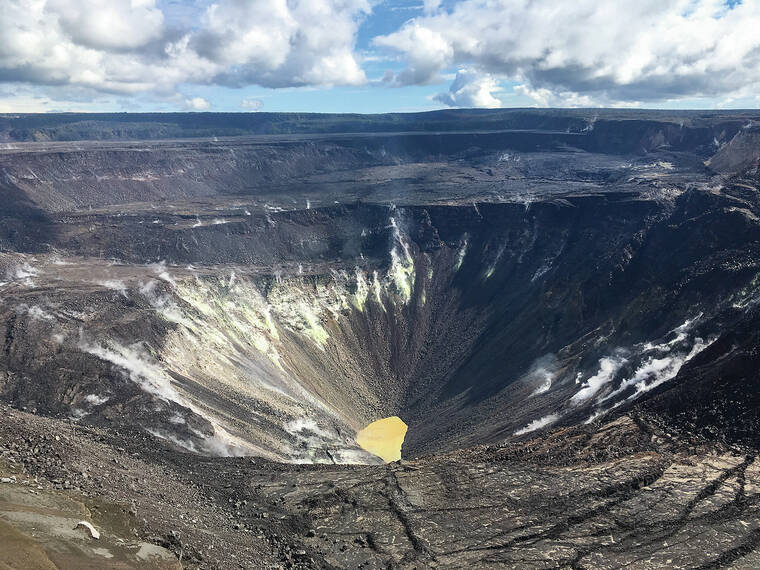Volcano Watch: Legends of eruptions past
Active volcanoes tell us their stories through earthquakes, deformation, gas emissions, and lava flows. We interpret those stories through myriad scientific instruments and record them in journals and news reports for generations to come. But what if a volcano isn’t active and hasn’t been in hundreds or even thousands of years? How can we learn their stories when now they slumber?
Geoscience is full of tools to help us investigate the past. Using geochemistry and geochronology, for instance, we can reconstruct ancient magma chambers from their eruptive products even millennia after they formed. There is one important tool, however, that can sometimes be overlooked: oral history.
ADVERTISING
Long before we were writing books or reading seismographs, our ancestors were recording events in their memories and passing them down through stories, poetry, and song. Today, we call them myths, legends, or oral traditions, and we can imagine these colorful stories being told for entertainment.
Good stories, however, are usually rooted in real events, if you know how to look. Hawaiian oral traditions are full of riveting stories — like the two chiefs of Kahuku who became the two hills of Napu‘uapele — that can be traced in some cases directly to the eruptions they record. In other parts of the world, however, the connection is not so straightforward. Time and artistic embellishment have disguised many volcanic eruptions in oral traditions. Let’s examine examples from Australia and Iceland.
The dreaming stories of the Bungandidj (Boandik) people tell of a giant named Craitbul who traveled across southeastern Australia with his family in search of a home. First, they settled at Mt. Muirhead. They dug their cooking oven and were settled in for the night when they were awakened by a shrieking bullin (bird) warning them of an evil spirit. They fled their home and built a new cooking oven at Mt. Schank.
Again, the bullin shrieked and chased the family from their rest. Eventually, they settled at Mt. Gambier. All was peaceful until one day water rose from the ground and destroyed their cooking fires. They dug their ovens again and again — four times! — and each time water rose to douse the flames, leaving gaping holes where their ovens once were. Finally, Craitbul and his family moved one last time and settled for good in a cave on the side of the peak.
This dreaming recalls several eruptions, ending with the formation of four crater lakes at a maar volcano, Mt. Gambier in southeast Australia, about 4,500 years ago. Many dreaming stories from eastern Australia describe volcanic eruptions that Aboriginal people had witnessed and passed down in story for thousands of years.
Another legend, passed down orally for hundreds of years in Iceland before being scribed by Snorri Sturluson, recounts a great duel between the god Thor and a giant, Hrungnir.
It begins with the pounding of hooves as Thor’s father, Odin, raced Hrungnir from Jötunheim, the land of the giants, to Asgard, the land of the gods. The gods invited Hrungnir for a feast, but soon he became loud and boastful, saying that he would kill the gods. He challenged Thor to a duel, and the two clashed brutally into the night. At one point, Hrungnir tries to protect himself by standing atop his great stone shield, thinking Thor would attack him from beneath the Earth. Instead, Thor hurled his mighty hammer from above. It collided with Hrungnir’s whetstone in mid-air with a thunderclap, showering the land with sparks and shattered fragments.
Rumbling hooves, bellowing giants on enormous stone shields, sparks and shattered stone raining from above… sounds like an eruption, doesn’t it? So, why not just call it that? Why cloak these events in flowery language and turn them into myths or legends? Because that’s how we’ll remember them for thousands of years.
Earth events fade from memory within a generation or two, but great stories become myths, legends, or oral traditions that are remembered far longer. We are wise, then, to listen to stories that our ancestors have passed to us for clues about Earth’s history. Next time you come across a tale from long ago, imagine what real events may be hidden in the story.
Volcano activity updates
Kilauea is not erupting. Its USGS Volcano Alert level is ADVISORY.
Webcams show no signs of active lava in Halema‘uma‘u crater, at the summit of Kilauea in Hawai‘i Volcanoes National Park. Over the past week, summit tiltmeters showed inflation and seismicity remains elevated beneath Kilauea summit and Namakanipaio. The summit sulfur dioxide (SO2) emission rate was most recently measured on May 24, when it totaled 90 tonnes per day.
Mauna Loa is not erupting. Its USGS Volcano Alert Level is at NORMAL.
Webcams show no signs of activity on Mauna Loa. Seismicity remains low. Summit ground deformation rates show inflation above background levels, but this is not uncommon following eruptions. SO2 emission rates are at background levels.
There were four earthquakes with 3 or more felt reports in the Hawaiian Islands during the past week: a M3.1 earthquake 8 km (5 mi) W of Volcano at 4 km (2 mi) depth on May 20 at 4:08 p.m. HST, a M3.7 earthquake 2 km (1 mi) SW of Volcano at 0 km (0 mi) depth on May 20 at 1:04 p.m. HST, a M3.1 earthquake 8 km (4 mi) W of Volcano at 4 km (2 mi) depth on May 20 at 1:02 p.m. HST, and a M3.6 earthquake 3 km (1 mi) WSW of Pahala at 35 km (22 mi) depth on May 19 at 1:10 a.m. HST.
HVO continues to closely monitor Kilauea and Mauna Loa.
Please visit HVO’s website for past Volcano Watch articles, Kilauea and Mauna Loa updates, volcano photos, maps, recent earthquake information, and more. Email questions to askHVO@usgs.gov.
Volcano Watch is a weekly article and activity update written by U.S. Geological Survey Hawaiian Volcano Observatory scientists and affiliates.


